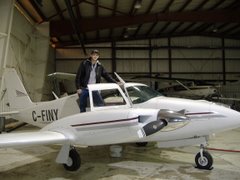My pay structure is based on a base salary pay as well as an additional rate per mile I fly. Even though my employers do the tally at the end of month for my paycheque, I have still been keeping track on my own as well. Up until now I've kept a simple tally on a spreadsheet. I made a list of all my usual trips, with a column for distance to home base beside the routes, and a column for the number of times I've flown each route. At the end of the day I'd update each route tally, and the spreadsheet would sum the numbers for me.
It has worked well enough up until now, with the three main drawbacks to it. The first being the extra time I have each day doing record keeping I hate. Also there's been a couple times where the next day I couldn't remember if I did it or not for the previous day, and have been at the risk of either not recording flights or recording them twice, since the spreadsheet was not a log, just a tally - so it could be prone to error. Lastly my tally spreadsheet was limited in the ability to track mileage that didn't involve flying back to home base.
Well, I had some time tonight, so I've just gone high-tech. For some time now in addition to my paper pilot logbook I've also kept a pilot logbook on spreadsheet in excel so if I ever lose one copy my career is still accounted for. Also keeping a pilot log on spreadsheet makes it easy to keep track of every conceivable combination of hours I need to, such as time on each aircraft type, time in the last 30 days, 90 days, and 12 months, PIC times for single engine, multi-engine, and day and night for both categories, etc since I've programmed all those functions in. Included in that spreadsheet log is also the record of the route of each flight in the form of departure aerodrome and arrival aerodrome, so the information to calculate mileage had the potential to be tracked from this digital logbook... time for some programming!
I created a database on another worksheet of every airport in the area that I visit, which included their 4 letter ident code and the latitude and longitude coordinates, which I easily found from the CFS publication (Canada Flight Supplement - a publication of every aerodrome in canada).
I also already had the formula for calculating distance between points on a spherical surface (aka earth) from a program I wrote a couple years ago, so I didn't even need to do any math research, I already had the code, which just needed to be tweaked. Two hours later, voila, no more manually tracking my mileage. The computer now retrieves the route information for each flight, cross references the airport code with the lat-long database and calculates the distance between the departure and arrival points, which it spits out in a running-total ledger style form, with the monthly total mileage at the top. I love computers.
Subscribe to:
Post Comments (Atom)




Very cool, Chad to have needed data with the click of a button!
ReplyDelete